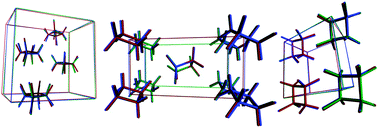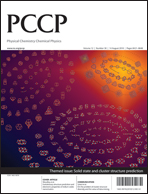A theoretical investigation of the packing stabilities of three small organic halogen compounds is presented based on a crystal structure prediction (CSP) study. Each compound has four identical halogen atoms (fluorine, chlorine, and bromine) and a four-membered ring consisting of carbon and sulfur atoms arranged alternately. Two halogen atoms are attached to each carbon and two oxygen atoms are attached to each sulfur forming SO2 functional groups. The crystal structures of these compounds have been determined experimentally and show distinct packing arrangements. Utilising the computational approaches implemented in the GRACE software package, each compound is subjected to a full CSP study using a force field specific for each molecule (called the tailor-made force field or TMFF) and a dispersion corrected solid-state density functional method (or DFT(d) method). Energetically feasible crystal structures are generated in all 230 space groups restricted to a single molecule in the crystallographic asymmetric unit (Z′ = 1) using the TMFF of each molecule. Next, a selection of structures with low TMFF lattice energies are further refined with the DFT(d) method. The CSP results show that the experimental crystal structures of the molecules containing fluorine and chlorine are well described energetically and geometrically by their TMFFs and the DFT(d) method. Both approaches locate their experimental lattices as the most stable structures. For the molecule containing bromine, a crystal structure corresponding to the force field optimised experimental structure is located as the second structure in the list of force field predicted structures, ranked by calculated lattice energy. Despite the structural similarity of the predicted and experimental structures, close examination of the DFT(d) optimisation results of the experimental structure reveals a slightly lower energy structure than that found by the CSP simulations. Furthermore, minimisation of the force field optimised structure using the DFT(d) method does not lead to the same minimum as the DFT(d) optimised experimental structure. Based on the CSP results and isostructurality among these three compounds, two new potential polymorphs for the molecules containing chlorine and bromine are proposed. These polymorphs might be obtained experimentally under the right crystallisation conditions.

You have access to this article
 Please wait while we load your content...
Something went wrong. Try again?
Please wait while we load your content...
Something went wrong. Try again?


 Please wait while we load your content...
Please wait while we load your content...